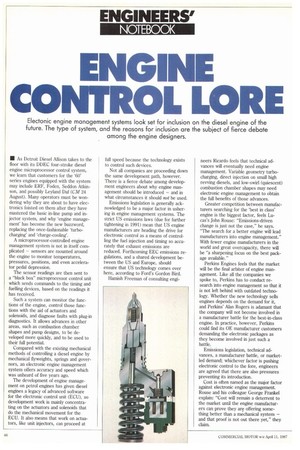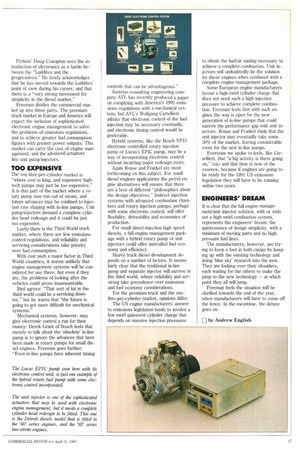ENGINE CONTROL LOR
Page 48

Page 49

If you've noticed an error in this article please click here to report it so we can fix it.
• As Detroit Diesel Allison takes to the floor with its DDEC four-stroke diesel engine microprocessor control system, we learn that customers for the '60' series engines equipped with the system may include ERF, Foden, Seddon Atkinson, and possibly Leyland Daf (CM 24 August). Many operators must be wondering why they are about to have electronics foisted on them after they have mastered the basic in-line pump and injector system, and why 'engine management has become the new buzzword, replacing the once-fashionable 'turbocharging' and 'charge-cooling'.
A microprocessor-controlled engine management system is not in itself complicated — sensors are mounted around the engine to monitor temperatures, pressures, positions, and even accelerator pedal depression.
The sensor readings are then sent to a "black box" microprocessor control unit which sends commands to the timing and fuelling devices, based on the readings it has received.
Such a system can monitor the functions of the engine, control those functions with the aid of actuators and solenoids, and diagnose faults with plug-in diagnostics. It allows advances in other areas, such as combustion chamber shapes and pump designs, to be developed more quickly, and to be used to their full potential.
Compared with the existing mechanical methods of controlling a diesel engine by mechanical flyweights, springs and governors, an electronic engine management system offers accuracy and speed which was unheard of five years ago.
The development of engine management on petrol engines has given diesel engines a legacy of advanced software for the electronic control unit (ECU), so development work is mainly concentrating on the actuators and solenoids that do the mechanical movement for the ECU. It also means that work on actuators, like unit injectors, can proceed at full speed because the technology exists to control such devices.
Not all companies are proceeding down the same development path, however. There is a fierce debate among development engineers about why engine management should be introduced — and in what circumstances it should not be used.
Emissions legislation is generally acknowledged to be a major factor in ushering in engine management systems. The strict US emissions laws (due for further tightening in 1991) mean that US engine manufacturers are heading the drive for electronic control as a means of controlling the fuel injection and timing so accurately that exhaust emissions are reduced. Forthcoming EEC emissions regulations, and a shared development between the US and Europe, should ensure that US technology comes over here, according to Ford's Gordon Bird.
Hamish Freeman of consulting engi
neers Ricardo feels that technical advances will eventually need engine management. Variable geometry turbocharging, direct injection on small high revving diesels, and low-swirl (quiescent) combustion chamber shapes may need electronic engine management to obtain the full benefits of those advances.
Greater competition between manufacturers searching for the 'best in class' engine is the biggest factor, feels Lucas's John Rouse: "Emissions-driven change is just not the case," he says. "The search for a better engine will lead manufacturers into engine management." With fewer engine manufacturers in the world and great overcapacity, there will be "a sharpening focus on the best package available."
Perkins Engines feels that the market will be the final arbiter of engine management. Like all the companies we spoke to, Perkins has to conduct research into engine management so that it is not left behind with outdated technology. Whether the new technology sells engines depends on the demand for it, and Perkins' Alan Rogers is adamant that the company will not become involved in a manufacturer battle for the best-in-class engine. In practice, however, Perkins could find its OE manufacturer customers demanding the electronic packages as they become involved in just such a battle.
Emissions legislation, technical advances, a manufacturer battle, or marketled demand; whichever factor is pushing electronic control to the fore, engineers are agreed that there are also pressures preventing its introduction.
Cost is often named as the major factor against electronic engine management. Rouse and his colleague George Frankel explain: "Cost will remain a deterrent to the market until the engine manufacturers can prove they arv offering something better than a mechanical system — and that proof is not out there yet," they Perkins' Doug Crampton sees the introduction of electronics as a battle between the "Luddites and the progressives." He freely acknowledges that he has moved towards the Luddites' point of view during his career, and that there is a "very strong movement for simplicity in the diesel market."
Freeman divides the commercial market up into three parts. The premium truck market in Europe and America will expect the inclusion of sophisticated electronic engine management to solve the problems of emissions regulations, and to achieve greater fuel consumption figures with greater power outputs. This market can carry the cost of engine management, and the advanced actuators Like unit pump/injectors.
TOO EXPENSIVE
The one-litre-per-cylinder market is "where cost is king, and expensive hightech pumps may just be too expensive." It is this part of the market where a rotary pump may run out of steam, and future advances may be confined to injection rate shaping with in-line pumps. Unit pump/injectors demand a complete cylinder head redesign and it could be just too expensive.
Lastly there is the Third World truck market, where there are few emissions control regulations, and reliability and servicing considerations take priority over fuel consumption.
With cost such a major factor in Third World countries, it seems unlikely that engine management systems will be considered for use there, but even if they are, the problems of looking after the vehicles could prove insumountable.
Bird agrees: "That sort of kit in the third world could be a servicing disaster," but he warns that "the future is going to get more difficult for mechanical systems."
Mechanical systems, however, may give electronic control a run for their money: Derek Grant of Bosch feels that merely to talk about the 'obsolete' in-line pump is to ignore the advances that have been made in rotary pumps for small diesel engines. Freeman goes further: "Even in-line pumps have inherent timing The Lucas EPIC pump seen here with its electronic control unit, is just one example of the hybrid rotaly fuel pump with some electronic control incorporated.
The unit injector is one of the sophisticated actuators that may be used with electronic engine management, but it needs a complete cylinder head redesign to be fitted. This one is the Detroit diesels model that is fitted to the '60' series engines, and the '92' series two-stroke engines. controls that can be advantageous."
Austrian consulting engineering company AVL has recently produced a paper on complying with America's 1991 emissions regulations with a mechanical system, but AVL's Wolfgang Cartellieri admits that electronic control of the fuel injection may be necessary eventually, and electronic timing control would be preferable.
Hybrid systems, like the Bosch VP15 electronic-controlled rotary injection pump or Lucas's EPIC pump, may be a way of incorporating electronic control without incurring major redesign costs.
Again Rouse and Frankel are most forthcoming on this subject. For small diesel engines applications the petrol engine alternatives will ensure that there are a host of different "philosophies about the design objectives." Indirect injection systems with advanced combustion chambers and rotary injection pumps, perhaps with some electronic control, will offer flexibility, driveability and economies of production.
For small direct-injection high speed diesels, a full engine management package with a hybrid rotary pump or unit injectors could offer unrivalled fuel economy and efficiency.
Heavy truck diesel development depends on a number of factors. It seems fairly clear that the traditional in-line pump and separate injector will survive in the third world, where reliability and servicing take precedence over emissions and fuel economy considerations.
For the premium truck and the onelitre-per-cylinder market, opinions differ.
The US engine manufacturers' answer to emissions legislation tends to involve a low swirl quiescent cylinder charge that depends on massive injection pressures to obtain the fuel/air mixing necessary to achieve a complete combustion. Unit injectors will undoubtedly be the solution for these engines when combined with a complete engine management package.
Some European engine manufacturers favour a high-swirl cylinder charge that does not need such a high injection pressure to achieve complete combustion. Freeman feels that with such engines the way is open for the new generation of in-line pumps that could narrow the performance gap with unit injectors. Rouse and Frankel think that the unit injector may eventually take some 50% of the market, leaving considerable room for the new in-line pumps.
Everyone we spoke to feels, like Cartellieri, that "a big activity is there going on," (sic) and that time is now of the essence, because if engines are going to be ready for the 1991 US emissions legislation they will have to be running within two years.
ENGINEERS' DREAM
It is clear that the full engine management/unit injector solution, with or without a high swirl combustion system, represents the engineers' dream: the quintessence of design simplicity, with a minimum of moving parts and no highpressure fuel lines.
The manufacturers, however, are trying to keep a foot in both camps by keeping up with the existing technology and doing 'blue sky' research into the new They are looking over their shoulders, each waiting for the others to make the jump to the new technology — at which point they all will jump.
Freeman feels the situation will be clarified towards the end of the year, when manufacturers will have to come off the fence. In the meantime, the debate goes on,




























































































